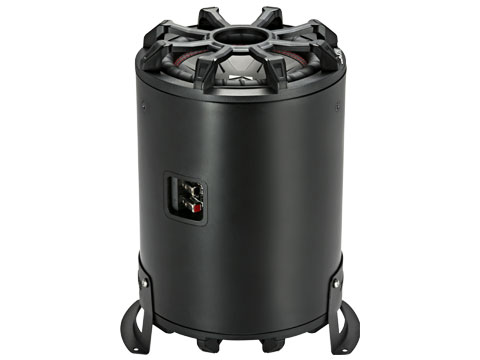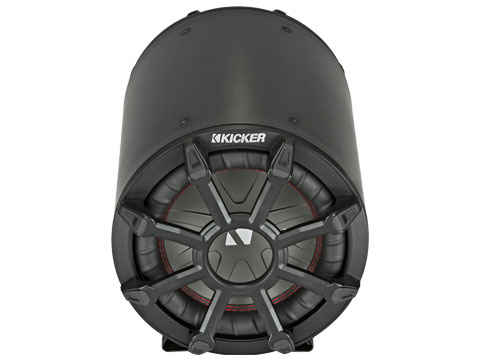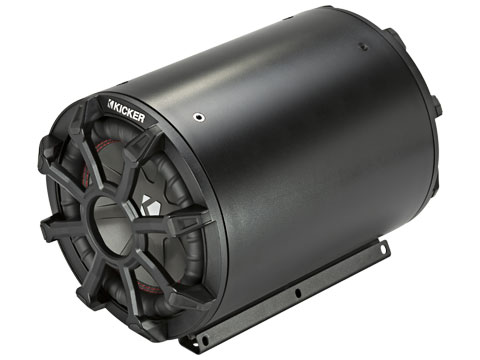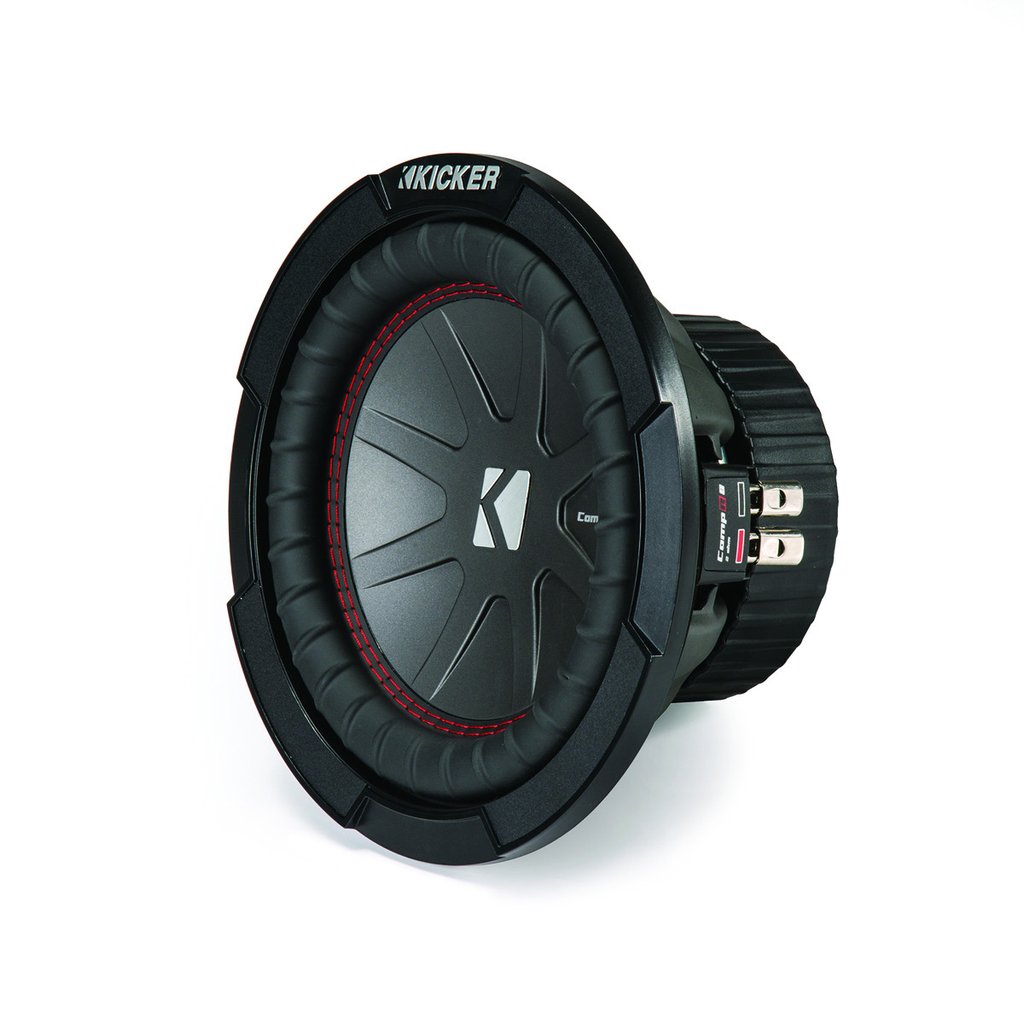KICKER CWTB8 DRIVEN/PBR BASS TUBE
Product Details: Eight inch Kicker CompR subwoofer, plus passive bass radiating cone, in a tube enclosure
Manufacturer: Kicker
Distributor: Celsus Ice
Website: UK Distributor: https://kickeruk.com/collections/tb-enclosures/products/cwtb82
Suggested Selling price: £299.99 (ten inch model is £349.99)

In A Nutshell
A Mighty Atom of Bass, designed for places that might get wet. Rated at 300 W continuous, it does the best of both sealed and ported boxes’ performance, with huge radiating area as well. Can be mounted vertically or on its side with good supplied hardware. Just two ohms impedance on this version, means it will draw massive power from your amp. Showing two ohms to a pair of bridged channels means it could suck your amp to death, at an ohm per channel, so check that your amp can cope or get the 4 ohm version.

SCORES
Sound Quality 8
Appearance 10
Ease Of Use 10
Features 10
Value For Money 9
Overall 9.4
BEST BUY & RECOMMENDED

What It Is
A short bass tube with mounting brackets fit for upright or sideways mount and a single set of spring terminals to attach an amplified speaker wire to. It has an eight inch speaker, wired to show two ohms to the terminals as well as a cone on the other end. This is known as a Passive Bass Radiator or PBR. It allows the main speaker driver to wobble down to its lowest possible resonant frequency (which ports often do not) to get a true 30Hz low end F3 or the frequency at which the bass is three decibels quieter, or ‘down’. This is a halving and means that there is still usable bass below this ‘cut-off’ frequency.
Editor Review : Kicker KA45CWTB82
My first ever experience of deep bass for car use was in a shop on the Tottenham Court Road in the late Eighties, It was a ten inch ‘Collins’ tube that had a ten up one end and a piece of MDF across the other end, with a bit of flat MDF used to form a short orange-segment shaped port of sorts. It was just in the shop in free space, running and grunting and I was impressed as hell. I didn’t know that Southern Audio Services or SAS in the USA were the guys who figured they owned the idea, having used a cylinder for an enclosure before anyone else. Later, I worked for ‘American Autosounds’ who imported those Collins tubes and discovered that they were made of compressed cardboard like a loo roll but thicker and that their drivers were so cheap as to make the units literally disposable if they went wrong. Plenty did – the boss even called them a ‘cheeky product’ meaning the supplier had some brass neck to even offer up such fragile pieces of tat!
And yet they sounded awesome, with any damn speaker in it! I swagged a dead ten inch and put a Cerwin-Vega driver in the end. It played like a brute.
And that cylinder, just like a sphere, has some physics on its side, since to ‘inflate’ it needs to literally stretch the entire fabric of the enclosure. That changes the acoustic force’s end ‘fight’. From one where it is pushing sideways against a flat box panel and finds it easy to deform – hence why top end enclosures are braced internally – to one where the tensile strength of the material is the issue. Thus Elipson and Anthony Gallo are famed for their spheres, while Eclipse are legendary for egg shaped speakers. All these use the same physics to create incredible sounding inert boxes. https://galloacoustics.com/ https://www.eclipse-td.com/uk/ http://www.elipson.com/gb/tribute/52-132-bs-50-tribute.html#/26-color-white_mat
Hilariously, Bazooka once thought that they could patent an IDEA as against merely their own cunning front-ported injection moulded DESIGN of bass tube. They wanted to own the very term ‘Bass Tube’ like that in caps, as proper noun that they own. I was even sent a legal affadavit form to fill all about it. Unfortunately, I didn’t play ball and filled it in with the logic laid out about above, complimenting them on a brilliant execution but saying that the term ‘bass tube’ was a generic as ‘ICE’ as a term at the time and accepted in general.
Now THIS is a Bass Tube…
So just what if you get a really solid walled tube and then load it with a stumpy little bastard of a Kicker subwoofer? One with a point to prove? ‘Just’ an eight but with an attitude problem, this tiny woofer is built like a brick shit house, like its big brothers and has enough voice coil on the back to make it need an ASBO.
Then what if, instead of a port, you use a passive bass radiator- or what looks like a whole second loudspeaker? Only it isn’t. A port will give you a lovely phat lump of extra bass at the tuned frequency which drops away quite fast below that frequency. A sealed box will drop as deep as the wobbliness or compliance of the woofer allows. Each woofer has a specification that refers to the frequency that the speaker’s moving parts will naturally resonate or wobble at the happiest. This is often deeper than where you would ‘tune’ a port. But a passive bass radiator will not only allow huge extra sound pressure level from pushing lots of air around, just like a port, but it will also allow the bass to drop as deep as the woofers’ suspensions allow.
How Well Does It Work?
So is it huge in output for the size? I plugged the subwoofer output of the recently reviewed Caliber RMD 579DAB-BT source unit https://www.adamrayner.net/caliber-rmd-579dab-bt-head-unit/ into the the resident test bench amplifier. A Genesis STEREO 100 but only using the subwoofer output RCA. Then, I balanced the amount of bass versus the main music by adjusting the gains on the amplifier against the output of the on board 4x30W RMS. The tube is rated at 300W RMS or twice that on peak, so really, my test was about efficiency as much as anything, as I was using only a 100W amp. However the review here: https://www.adamrayner.net/genesis-stereo-100/ clearly shows the amp I have, actually makes 300W! AND into 4 Ohms bridged, not two. It is supposed to not do that but it did and may even have been making a bit more power than that. But everything got a bit warm on the test bench. I did enjoy it as you can see from the video.
Why Buy It?
It isn’t cheap but then it IS head, shoulders and hairy chest above anything made by a UK supplied brand, sold in the declining megastores. It has a reassuringly weighty feel to it and the bracketry alone assures you that these folks properly understand bass in cars. And boats. And beach buggies….. The sound is absurdly bigger than the box and pressurised my room, which is much bigger than most vans. I suspect it of being able to underpin big systems and I liked the smooth even, deep dropping flavour of bass that this Kicker CWTB8 creates.
Full Features & Specifications
- Driven eight inch subwoofer and passive eight inch cone
- CompR driver with high power handling of 300W RMS
- Ceramic magnet, ribbed Santoprene™ surround, double red stitched
- Uniplate™ solid pole piece long excursion design with T shaped top plate
- Passive cone has same SoloKon™ build structure with 360º back bracing
- Impedance is just 2 Ohms, although 4 Ohm Dual Voice Coil is available
- Can be vertically or horizontally mounted using supplied hardware
- ABS polymer construction, spring loaded terminals
- IP66 Water Resistant rating
- C/W grilles, vertical mounting brackets, horizontal mount base, horizontal mount hook(retainer), horizontal mount plate(retaining clamp), stainless steel M5 x 12mm button head screws for horizontal mount plate to base and mounting brackets to enclosure, nylon flat washers (to be used on all mounting fasteners), stainless steel pan head Phillips M4 x 25mm (for mount base to vehicle), manual, Kicker stickers!

